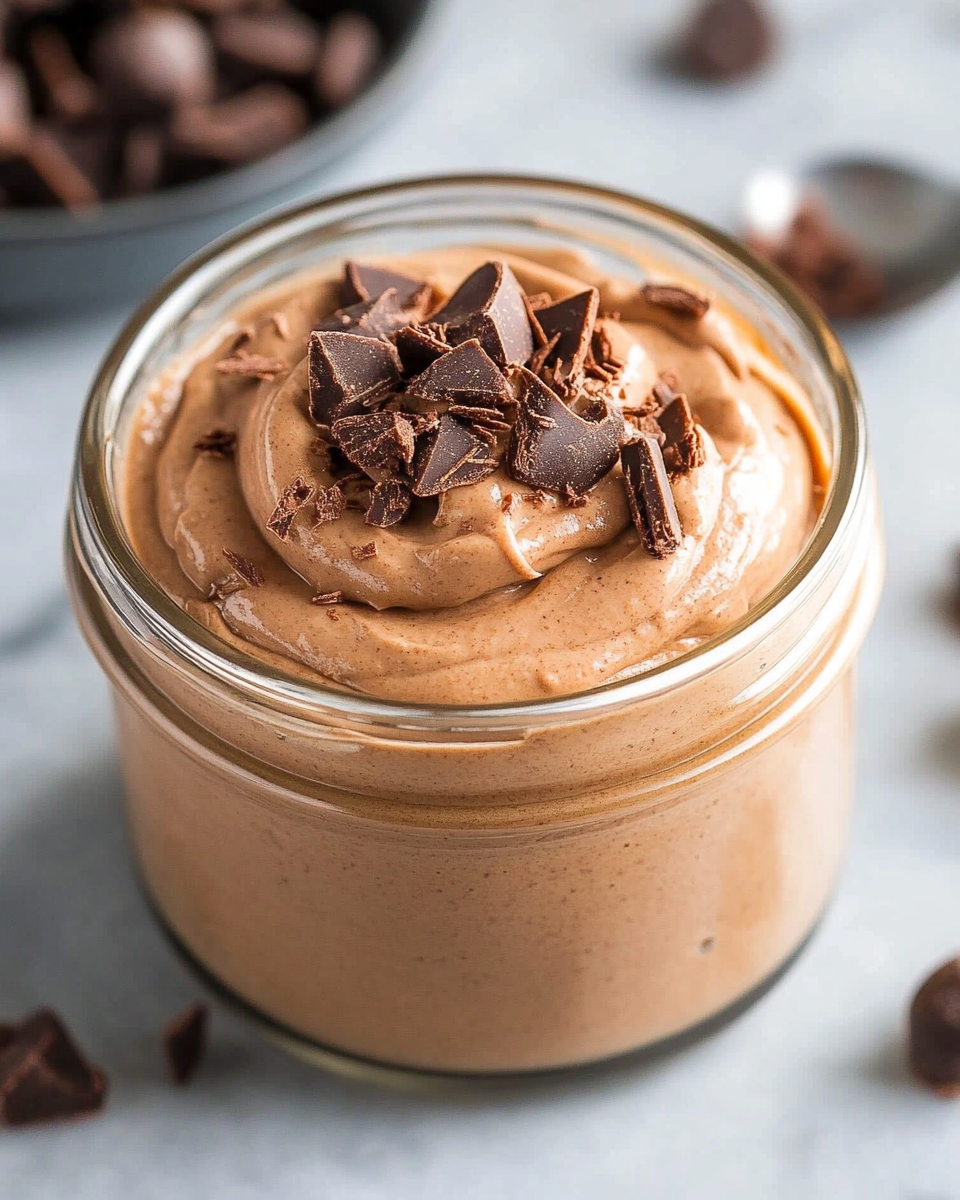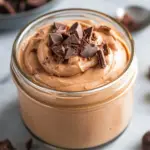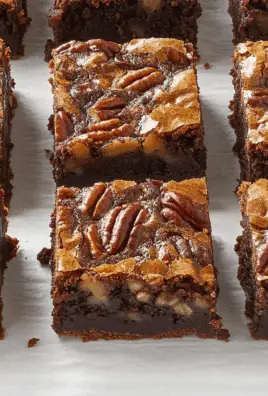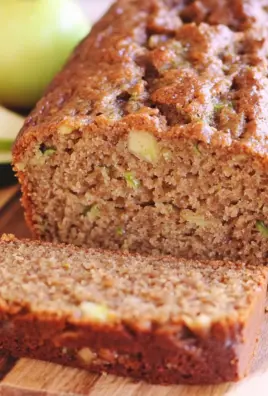Protein pudding is a creamy, no-cook, high-protein dessert or snack that blends nutrient-rich ingredients like Greek yogurt, protein powder, and nut butter into one satisfying bowl. It’s ideal for anyone looking for a post-workout treat, a quick protein boost, or a healthier way to satisfy sweet cravings without compromising nutritional goals.
This recipe combines ease of preparation with powerful macros, making it a go-to for fitness enthusiasts, busy professionals, and even picky eaters. With just a few ingredients and no cooking involved, it’s ready in minutes and easily customizable to suit your taste.

Why You’ll Love This Recipe
- High-Protein: Packs around 20–30 grams of protein per serving.
- No-Cook and Quick: Ready in 5 minutes or less.
- Customizable: Use your favorite protein powder, nut butter, or flavor add-ins.
- Naturally Gluten-Free: Suitable for gluten-sensitive diets.
- Meal Prep-Friendly: Make ahead and store for up to 3 days.
Whether you need a healthy breakfast alternative, a post-gym recovery snack, or a late-night dessert, this protein pudding has you covered.
Recipe Appeal and Unique Features
This simple pudding isn’t just high in protein—it’s incredibly versatile:
- Works as a snack, breakfast, or dessert.
- Can be adjusted for texture, flavor, and dietary needs.
- Kid-friendly and fitness-approved.
- Perfect for meal prepping multiple portions at once.
Its main draw is that it uses basic pantry staples—like Greek yogurt and protein powder—yet still delivers creamy indulgence with a clean ingredient list.
Preparation Phase and Tools to Use
Making protein pudding is quick and requires minimal tools. Here’s what you’ll need:
Essential Tools and Equipment
- Mixing bowl: For combining all ingredients.
- Whisk or spoon: Helps achieve a smooth consistency.
- Measuring spoons and cups: For accuracy in macros and flavor.
- Storage container (if prepping ahead): Keeps the pudding fresh for later use.
Importance of Each Tool
- Mixing bowl: A deep enough bowl allows for proper blending without spillage.
- Whisk: Breaks up clumps in the protein powder, creating a smooth finish.
- Measuring tools: Ensure balanced nutrition and consistent taste.
- Storage container: Keeps the pudding airtight to prevent separation or drying.
Preparation Tips
To get the most out of your protein pudding:
- Use full-fat Greek yogurt for a creamier texture. Low-fat versions work too but may be tangier.
- Use a high-quality protein powder that blends well and complements the flavor. Chocolate and vanilla are great choices.
- Add a splash of milk (dairy or plant-based) only if needed. The texture should be thick but spoonable.
- Taste before sweetening. Protein powders vary in sweetness.
- If you like texture, chia seeds add bulk and extra fiber.
- Letting the pudding rest for 5 minutes can help thicken it further, especially if using chia seeds.
Ingredients
Base Ingredients
- 1 cup (250 g) Greek yogurt (full-fat for richness or low-fat for lighter version)
- ½ cup (40 g) protein powder (chocolate, vanilla, or unflavored)
- 1–2 tablespoons nut butter (peanut butter or almond butter work best)
- 1 tablespoon cocoa powder (optional, for chocolate flavor)
- 1–2 tablespoons maple syrup or honey (adjust based on sweetness of protein powder)
- Splash of milk of choice (almond, oat, dairy, etc. — only if needed to thin the pudding)
Optional Flavor Add-Ins
- ½ teaspoon vanilla extract
- 1 tablespoon chia seeds
- Pinch of sea salt
Step-by-Step Directions
- In a medium mixing bowl, add the Greek yogurt, protein powder, and nut butter.
- If using cocoa powder, vanilla extract, or sea salt, add them in at this stage.
- Stir everything together with a whisk or spoon until the mixture is smooth and uniform.
- If the pudding is too thick, add a small splash of milk. Stir and assess consistency before adding more.
- Taste for sweetness. Add maple syrup or honey as needed.
- For extra texture and thickness, stir in chia seeds and let the mixture sit for 5 minutes.
- Serve immediately or store in an airtight container in the refrigerator for up to 3 days.
Tips and Variations
- Use flavored protein powders to create different versions: chocolate peanut butter, vanilla chai, or even mocha.
- For a dairy-free version, use coconut yogurt and a plant-based protein powder.
- Add toppings like sliced bananas, berries, or a drizzle of almond butter to elevate the pudding.
- For a dessert-style treat, top with a few dark chocolate chips or shredded coconut.
This protein pudding recipe is a simple and effective way to boost your daily protein intake while enjoying a treat that feels indulgent but fuels your goals.
How to Serve Protein Pudding
This protein pudding is best served cold and thick, straight from the fridge. Its creamy texture makes it a satisfying standalone snack or dessert, but it also pairs well with various toppings and textures. Here are several ideas to enhance presentation, flavor, and nutritional value.
Topping Ideas
- Fresh fruit: Add sliced bananas, strawberries, blueberries, or mango for natural sweetness and fiber.
- Nut butter drizzle: A spoonful of almond or peanut butter on top adds flavor and healthy fats.
- Dark chocolate chips: For a dessert vibe, sprinkle a few on top.
- Coconut flakes: Adds texture and a subtle tropical note.
- Granola or crushed nuts: Introduce crunch and complexity.
- Chia seeds or flaxseeds: For extra fiber and omega-3s.
Creative Serving Styles
- Layered parfait: Alternate pudding with fruit and granola in a glass for a beautiful layered dessert.
- Frozen treat: Freeze the pudding in small silicone molds or ice cube trays for a protein-packed popsicle.
- Dip for fruit: Use as a dip for apple slices or strawberries for a kid-friendly snack.
Protein pudding is flexible enough to work with both light toppings or more indulgent combinations, depending on your dietary needs.
Common Mistakes to Avoid
Even though protein pudding is simple to make, a few missteps can affect the texture and flavor. Avoid these common mistakes for a smoother experience.
1. Choosing a gritty protein powder
Not all protein powders mix well. Some have a chalky or sandy texture. Opt for a high-quality blend that’s designed for baking or mixing into yogurt, such as whey isolate or a fine-textured plant-based option.
2. Using non-creamy yogurt
Non-fat or overly watery yogurts can create a thin or uneven consistency. Choose Greek yogurt that is thick and creamy. Full-fat varieties yield the richest results, but 2% also works well.
3. Over-thinning with milk
Adding too much milk can turn the pudding runny. Start with a teaspoon at a time and mix thoroughly before adding more.
4. Skipping the sweetness check
Protein powders vary in flavor and sweetness. Always taste the pudding before adding sweeteners. Some powders are already flavored and sweetened, and extra honey or maple syrup may be unnecessary.
5. Overmixing the ingredients
Whipping or over-stirring can sometimes make the texture gummy, especially with plant-based protein powders. Mix gently and stop as soon as the texture is smooth.
By avoiding these mistakes, you’ll ensure a smooth, flavorful, and protein-packed result every time.
How to Perfect the Recipe
Want to make your protein pudding even better? These tips help refine the process and boost flavor, texture, and overall enjoyment.
Use high-quality ingredients
- Choose a protein powder with clean ingredients and a flavor that complements your add-ins.
- Use thick, unsweetened Greek yogurt for better control over sweetness and texture.
Add flavor strategically
- Vanilla extract, cinnamon, or cocoa powder can significantly enhance flavor without extra calories.
- A pinch of sea salt can balance sweetness and boost overall taste.
Rest time matters
If using chia seeds or if the pudding feels slightly loose, let it sit for 5–10 minutes. This rest period allows thickening and gives the flavors time to meld.
Customize your mix-ins
- For a fiber boost: Add ground flaxseed or chia seeds.
- For extra richness: Stir in a teaspoon of melted coconut oil or a few drops of flavored stevia.
- For more volume: Fold in a couple of tablespoons of whipped topping or cottage cheese.
These enhancements take your protein pudding from basic to gourmet while staying within your nutritional goals.
Recommended Side Dishes and Pairings
Looking to create a more complete snack or meal? Pair protein pudding with any of the following sides for balanced nutrition and variety.
1. Mixed Berry Salad
A small bowl of mixed berries adds antioxidants, fiber, and color. Great for refreshing contrast.
2. Sliced Apple with Cinnamon
Apple slices provide crunch and natural sweetness. Sprinkle with cinnamon for extra flavor and blood sugar balance.
3. Gluten-Free Oatmeal Cookies
Pairing pudding with a soft oatmeal cookie makes for a satisfying afternoon snack.
4. Banana with Almond Butter
Classic and simple. A ripe banana with almond butter rounds out your macros and complements the pudding’s texture.
5. Cottage Cheese with Pineapple
This adds even more protein and a juicy, tropical element. Great if you want a heartier combo.
6. Rice Cakes with Nut Butter
Add one or two thin rice cakes topped with nut butter or sugar-free jam for crunch and carbs.
7. Roasted Nuts
A handful of roasted almonds or cashews gives you healthy fats and additional satiety.
8. Low-Carb Muffin
A homemade or store-bought keto-friendly muffin rounds out a low-sugar meal prep combo.
These sides not only boost nutritional value but also make your protein pudding feel like part of a complete meal or dessert experience.
Storage and Reheating Instructions
One of the advantages of protein pudding is its convenience for meal prep. It stores well and maintains flavor and texture for several days with the right approach.
Refrigerator Storage
- Transfer the prepared pudding into an airtight container immediately after mixing.
- Store in the refrigerator for up to 3 days.
- Stir gently before serving. The texture may thicken slightly as it rests, especially if chia seeds were added.
Freezer Tips
Freezing is not ideal for this recipe. The texture of Greek yogurt and protein powder may change after thawing, resulting in separation or graininess. However, you can freeze it in popsicle molds if you intend to eat it frozen.
Reheating
Protein pudding is intended to be served cold. Reheating is not recommended, as it can alter the protein structure and affect consistency.
Recipe Tips for Success
To get the best results every time, keep these key points in mind:
Choose the Right Ingredients
- Use unsweetened Greek yogurt for better control over flavor and sugar content.
- Select a smooth-blending protein powder. Whey isolate and some plant-based blends work well.
Mix Thoroughly
Avoid clumps by whisking or stirring slowly and consistently. Overmixing can cause gumming, especially with certain vegan protein powders.
Don’t Oversweeten
Always taste before adding sweeteners like maple syrup or honey. Some protein powders are already flavored and sweetened.
Let It Sit
If using chia seeds or cocoa powder, let the pudding sit for 5–10 minutes before eating. This improves both texture and flavor balance.
Customize with Purpose
Add-ins like vanilla extract, sea salt, or cinnamon can elevate flavor without adding calories. Keep texture in mind when mixing in ingredients like nuts or fruit.
Frequently Asked Questions (FAQs)
Is protein pudding good for weight loss?
Yes. Protein pudding is high in protein and low in added sugars, which makes it ideal for managing hunger and supporting weight loss. It helps you stay full longer, especially when made with high-quality ingredients.
Can I make protein pudding without protein powder?
You can, but the protein content will be significantly lower. Substitute with cottage cheese, silken tofu, or add collagen peptides if you want to boost protein without using flavored powders.
What kind of protein powder works best?
Whey isolate blends best and has a creamy finish. For dairy-free or vegan versions, choose a fine-textured plant-based protein such as pea or rice. Avoid gritty or overly fibrous powders.
Can I prep protein pudding in advance?
Absolutely. You can prepare several servings at once and store them in the refrigerator for up to 3 days. Use airtight containers to maintain freshness.
Is Greek yogurt better than regular yogurt for pudding?
Yes. Greek yogurt is thicker and higher in protein, making it ideal for protein pudding. Regular yogurt tends to produce a thinner, less satisfying texture.
How do I make vegan protein pudding?
Use dairy-free yogurt such as almond, coconut, or soy-based, and combine it with a plant-based protein powder. Maple syrup or agave can be used as natural sweeteners.
Why is my protein pudding chalky?
A chalky texture often comes from low-quality or poorly dissolving protein powders. Try a different brand, and make sure to mix thoroughly. Adding a splash of milk can also help improve texture.
Can I freeze protein pudding?
Freezing is not recommended for regular pudding. However, it can be frozen in molds to make high-protein frozen treats.
How many calories are in homemade protein pudding?
Calorie count varies depending on ingredients. A standard serving with Greek yogurt, protein powder, and nut butter has around 300 to 350 calories, with approximately 20–30 grams of protein.
Is this recipe keto-friendly?
It can be. Use full-fat Greek yogurt, unsweetened protein powder, and a keto-approved sweetener like stevia or erythritol. Avoid maple syrup and honey.
Conclusion
Protein pudding is a convenient, nutrient-dense option that fits into nearly any diet or lifestyle. It takes just minutes to prepare and can be tailored to suit your taste and nutritional needs. Whether you’re following a high-protein diet, looking for a healthier dessert, or need a post-workout recovery snack, this recipe delivers on every level.
Its simplicity is part of the appeal, but its versatility is what makes it a staple. Use it as a standalone treat, layer it into parfaits, or incorporate it into your weekly meal prep routine. With just a few ingredients and endless variations, protein pudding is one recipe that keeps giving.
For more high-protein snack ideas, check out our Greek Yogurt Snack Recipes or explore Easy No-Bake Desserts.
Let this pudding be the foundation for better snacking—delicious, easy, and packed with purpose.
Protein Pudding
Ingredients
- 1 cup 250 g Greek yogurt (full fat for creaminess or low fat for a lighter option)
- ½ cup 40 g protein powder (chocolate, vanilla, or unflavored)
- 1 –2 tbsp nut butter peanut or almond butter
- 1 tbsp cocoa powder optional
- 1 –2 tbsp maple syrup or honey adjust to taste
- Milk of choice almond, oat, or dairy milk – only if needed for thinning
- Optional Flavor Add-Ins
- ½ tsp vanilla extract
- 1 tbsp chia seeds
- A pinch of sea salt
Instructions
- In a mixing bowl, combine the Greek yogurt, protein powder, nut butter, and any optional ingredients like cocoa powder or vanilla extract.
- Mix thoroughly with a whisk or spoon until smooth and well-blended.
- If the pudding is too thick, add a splash of milk gradually until the desired consistency is reached.
- Taste and adjust sweetness by adding maple syrup or honey if needed.
- For added texture, stir in chia seeds and let the pudding sit for 5 minutes to thicken.
- Serve immediately or store in an airtight container in the refrigerator for up to 3 days.




Leave a Comment